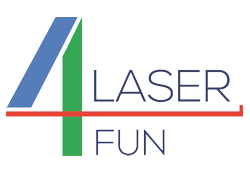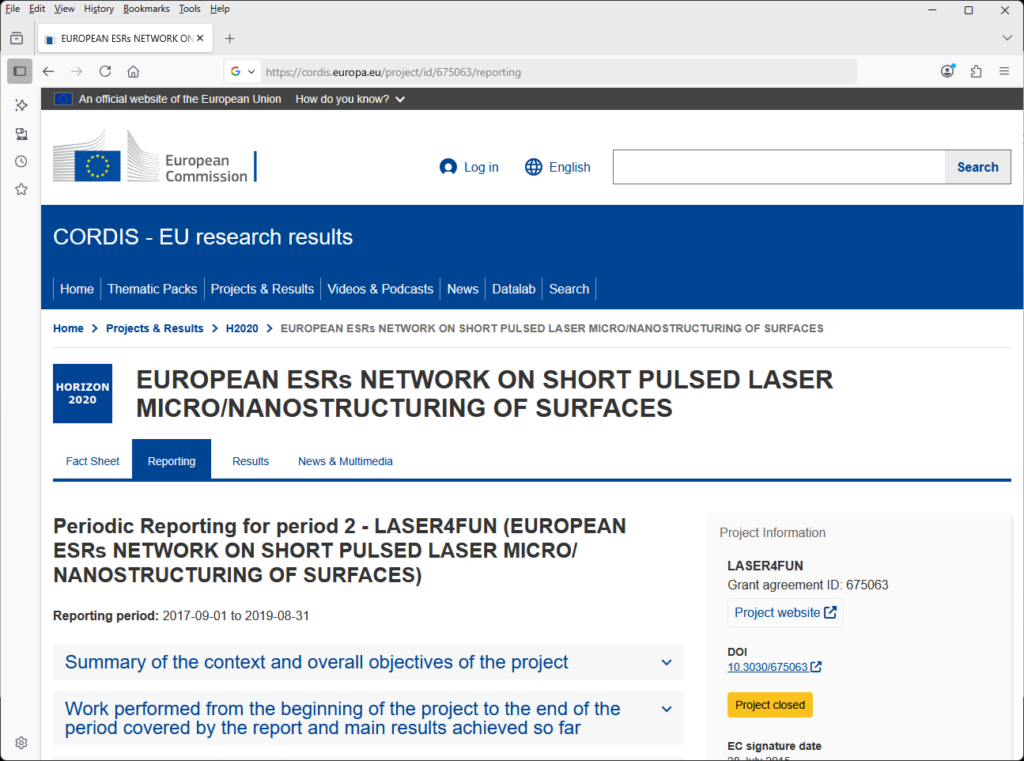On August 31st, 2019 the Laser4Fun project was completed by the successful delivery of all project requirements and the last deliverables. On the Cordis website of the European Commission, some of the project reports, results, as well as news & multimedia can be downloaded. A more detailed overview of publications and achievements is listed on our Publications page.
PhD awarded to Melissa Sikosana
On April 27th, 2022, during a partly on-line session, Melissa Sikosana successfully defended her PhD thesis, titled: ‘Antimicrobial coatings to maintain drinking water at point-of-use’ and was awarded the degree of Doctor.
Melissa carried out her work at the Leibniz-Institut für Polymerforschung Dresden e.V, under the supervision of Prof. Dr. Carsten Werner and Dr. Lars Renner. The now Dr. Sikosana was an Early Stage Researcher (ESR) of the Laser4FUN project. The public defense ceremony took place partly on-line at TU Dresden (Germany) and the audience could ‘attend’ the event through a video stream.
We congratulate Melissa for this achievement!
Summary of PhD thesis
Water is life. Yet, nearly a third of the global population is water insecure; with children under the age of five in low-income countries experiencing the brunt of this burden. Disinfection and safe water storage practices are vital to protect people against waterborne diseases. That said, the aim of this PhD study was to critically assess the potential of dual action antimicrobial coatings in advancing sustainable point-of-use water treatment. In this work, easy-to-apply antiadhesive and bactericidal surface coatings were developed to prevent initial bacterial adhesion and the subsequent formation of biofilms on polymeric surfaces. These coatings are based on a patented system of water-soluble, amphiphilic block copolymers of PEGylated styrene: maleic acid for in-situ biofunctionalization. On water relevant polymers surfaces (PE and PET), the coatings achieved up to 98 % and 10-fold reduction in cell viability and adhesion, respectively.
The work went a step further – it is acknowledged that a single antimicrobial approach is unlikely provide long-lasting protection against microbes in the environment. In fact, nature often uses a combination of physical and chemical components for superior surface protection (e.g. Collembola). In this direction, this work also explored the potential for a synergistic antiadhesive effects against bacteria cells to micrometric scale laser-textured features (by DLIP) on polymeric surfaces (PET), decorated with the antiseptic polymer-coating. This study revealed that this integrated approach can achieve an additive antiadhesive effect at specific feature periodicities. Looking forward, this work has significant implications on future studies aimed to better understand the complex physico-chemical interplay of bacteria-surface interactions.
PhD degree awarded to Alfredo Ismael Aguilar Morales
On April 7th, 2021, Alfredo Aguilar successfully defended his PhD thesis, titled “Microfabrication of multi-scaled metallic surfaces using Direct Laser Interference Patterning” and was awarded the degree of Doctor.
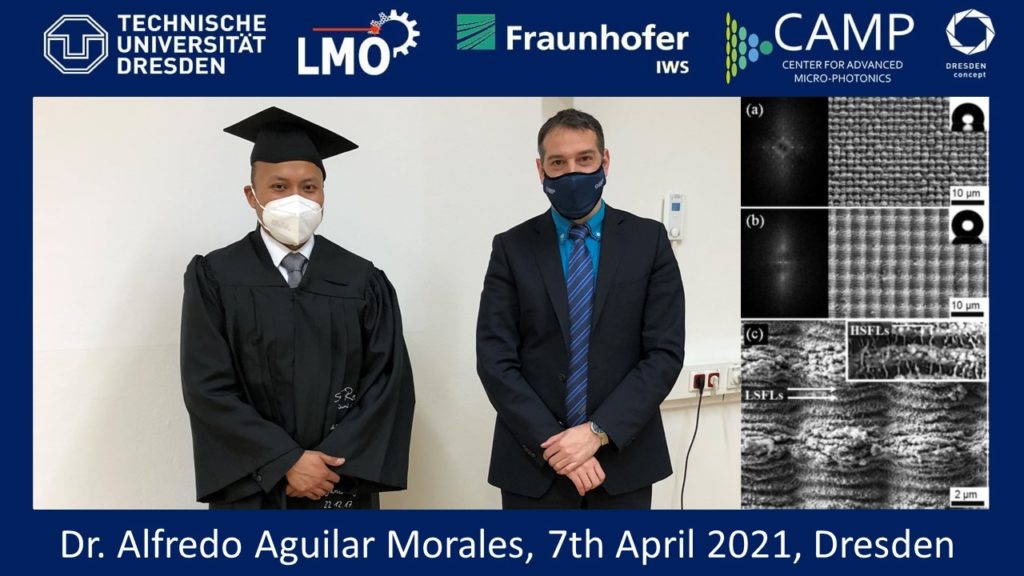
The work was carried out at Fraunhofer IWS (Dresden), as well as at the Technical University Dresden, both in Germany, under the supervision of Prof. Dr. Andrés Lasagni. The now Dr.-Ing. Aguilar Morales, was an Early Stage Researcher (ESR) of the Laser4Fun project. The public defense ceremony took place with “closed doors” at the Institute of Manufacturing Science and Engineering (IF) of TU Dresden (Germany), with the audience following the event through a video stream.
We congratulate Alfredo for this achievement!
Summary of PhD thesis
Bringing specific functions on surfaces by modifying their topographies is key task in surface engineering. Using laser based surface texturing technologies, such as Direct Laser Interference Patterning (DLIP), it is possible to produce well-defined patterns with elements having feature sizes in the micro- and nanometer range. Therefore, the aim of the PhD thesis is to explore new possibilities and strategies to produce structured surfaces in metals, using laser based approaches. The fabrication of hierarchical line- and pillar-like microstructures was addressed using the DLIP method ns and ps pulses. Based on the measured experimental data, the effect of different laser process parameters on the produced surface texture homogeneity were determined, being the hatch distance a fundamental parameter, while the pulse-to-pulse overlap can be used for efficiently controlling the structure depth. In the case of ps-laser radiation, the DLIP patterns were decorated with different types of LIPSS, producing again patterns with a three-level hierarchy. In addition, multi-scaled microstructures were produced applying DLW to produce micro-cells arrays which were later structured forming pillar-like elements using DLIP. After that, the produced structures were used to control different surface properties, including superhydrophobic structures as well as surfaces capable to reduce the coefficient of friction by 40%.
Phd degree awarded to Luigi Capauno
On December 4th, 2020, during a partly on-line session, Luigi Capuano successfully defended his PhD thesis, titled “Laser micro/nanoprocessing and subsequent chemical etching of sapphire for surface and bulk functionalization” and was awarded the degree of Doctor.
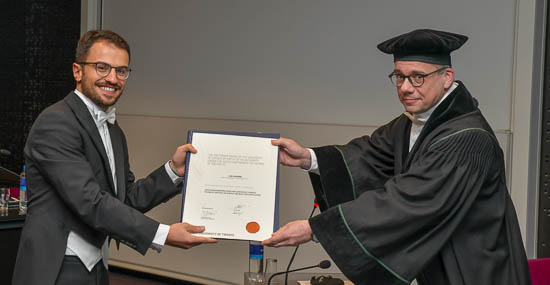
Luigi carried out his work at the Chair of Laser Processing at the University of Twente, under the supervision of prof. Gert-willem Römer and dr. Matthias Feinaeugle. Committee members were prof. Antonio Ancona (University West Sweden and University of Bari, Italy), prof. Bulgakova (HiLASE Centre, Institute of Physics AS CR, Czech Republic), prof. Gardeniers (University of Twente) and prof. García Blanco (University of Twente). The now Dr. Capuano was an Early Stage Researcher (ESR) of the Laser4Fun project. The public defense ceremony took place partly on-line at the University of Twente and the audience could “attend” the event partly through a video stream.
We congratulate Luigi with this achievement!
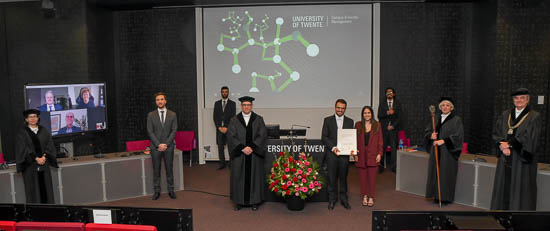
Links
PhD defense Luigi Capuano Dec. 4th, 2020
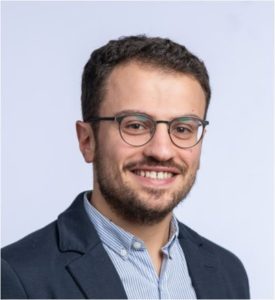 Luigi Capuano an Early Stage Researcher (ESR), will defend his PhD-thesis on December 4th, starting at 12:30 o’clock partly on-line and partly in room 4 of the Waaier building of the University of Twente in The Netherlands. Attendance of the latter is for invitees only. Supervised by prof.dr.ir. Gert-willem Römer and Dr.ir. Matthias Feinaeugle, Luigi carried out most of his work at the Chair of Laser Processing at the University of Twente. Below is a summary of the work and results of Luigi.
Luigi Capuano an Early Stage Researcher (ESR), will defend his PhD-thesis on December 4th, starting at 12:30 o’clock partly on-line and partly in room 4 of the Waaier building of the University of Twente in The Netherlands. Attendance of the latter is for invitees only. Supervised by prof.dr.ir. Gert-willem Römer and Dr.ir. Matthias Feinaeugle, Luigi carried out most of his work at the Chair of Laser Processing at the University of Twente. Below is a summary of the work and results of Luigi.
Summary
Synthetic sapphire (a-Al2O3) is a hard, transparent and mostly inert material. Because of its unique physical and chemical properties it is employed in many fields of technology. It is quite common, for example, to find sapphire in modern smartphones and watches. Crystalline sapphire can be processed using several techniques. Typical processing methods are: mechanical sawing/dicing, dry etching, wet etching and laser processing. In contrast with the other methods, material processing through lasers is fast, precise and flexible in terms of different materials and geometries. In this thesis, a two-step processing sequence to fabricate microstructures in/on sapphire substrates is presented and discussed. This two-step technique consists of ultra-short (typically picosecond or femtosecond) pulsed laser irradiation and subsequent chemical etching of sapphire. The radiation of focused ultra-short laser pulses can trigger non-linear effects in the material resulting in the material modification of sapphire. In particular, in the affected focal region of the laser beam, the molecular structure can be transformed from crystalline to amorphous. While crystalline sapphire is very inert and resistant to most chemical etchants, amorphous Al2O3 is reactive and can be selectively etched, permitting to create empty structures in sapphire which may be used for example as microfluidic channels. The method is still not fully exploited in industry due to several unresolved scientific and practical issues. The main objective of this thesis is to address some of these issues in order to achieve an optimized processing technique. To that end, first the physical phenomena governing laser-material interaction of subsurface laser processing of sapphire are studied and analysed. This is needed because, due to the complexity of these phenomena, the effect of processing conditions on the final structures is not yet fully understood. Therefore, a model is presented, which is used to simulate the interaction between the laser light and the sapphire during and directly after the ultrashort laser-pulse duration. The laser absorption phenomena considered in the model are: free electron absorption, multiphoton absorption, tunneling ionization, avalanche ionization, recombination of carriers, diffusion of carriers and heat diffusion. A main discovery from the simulations is that avalanche ionization plays a major role in the modification of the material. In fact, until the avalanche ionization is triggered inside sapphire, the other absorption mechanisms induce only a slight increase in the temperature of the lattice of sapphire. Moreover, a “shielding” effect was identified. That is, locations at which the laser energy is absorbed are also the locations at which free electrons are generated. In turn these free electrons absorb more laser energy, which “shield” lower regions of the material from the laser beam. To understand the effect of laser-processing conditions and, in order to establish optimized laser parameters (such as: laser pulse energy, laser pulse repetition rate, laser pulse duration and focal depth below the surface) to obtain uniform amorphous structures in sapphire, experimental analysis was performed using a picosecond laser source, as well as a femtosecond laser source. Several structures are presented and discussed produced in the bulk and on the surface of sapphire. It was determined that femtosecond pulses (230 fs) are best suited for the hybrid method of processing. Moreover, it was found that, there is a specific processing window at which the structures obtained show less cracks as well as uniform amorphized sapphire regions. The laser intensity must be high enough (> 1013 to 1014 W/cm2) to amorphize the material but, if an excessive intensity is used, the material cracks. To obtain an uniform and undivided amorphous volume, the laser pulse repetition rate must be at least 100 kHz, but, if a repetition rate higher than 1 MHz is used, the material breaks. Finally, the effect of two different selective etchants on the final morphology of the empty/hollow structures obtained after the etching phase is studied. Hydrofluoric acid (50% stagnant solution at room temperature) is the most used etchant in this thesis. The hollow/empty structures obtained after etching in this etchant are identical to the shape of the amorphized regions before etching (that is, the crystalline material is not noticeably etched). The use of a mixture of sulfuric acid and phosphoric acid (H2SO4 + H3PO4) at 180°C to etch the structures obtained with this technique, results not only in the fast etching of the amorphized material, but also in anisotropic etching of crystalline sapphire. A series of different structures were fabricated on the surface and in the bulk of sapphire to demonstrate the potential of the anisotropic etching of sapphire. The structures were analysed before etching and after several etching periods. The anisotropic etching of the crystalline sapphire of the modifications revealed structures showing well-defined geometrical shapes (trapezohedrons and tetrahedrons) and an etching-induced periodic pattern.
PhD degree awarded to Marek Mezera
During an on-line session on October 16th, 2020, Marek Mezera successfully defended his PhD thesis, titled “Picosecond laser-induced periodic surface structures – Progress strategies for metals, silicon and polymers” and was awarded the degree of Doctor.
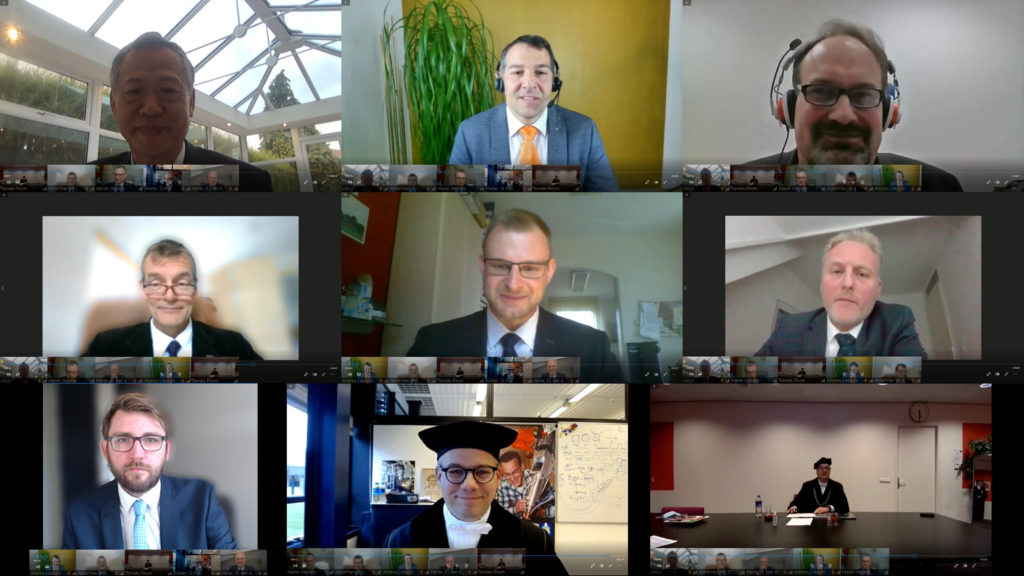
The work was carried out at the Chair of Laser Processing at the University of Twente, under the supervision of prof. Gert-willem Römer and dr. Dave Matthews. Committee members were prof. Koopman (University of Twente), prof. Lasagni (Technical University Dresden, Germany), prof. Li (University of Manchester, UK), dr. Bonse (BAM, Germany), prof. Akkerman (University of Twente) and prof. van der Heide (University of Twente). The now Dr. Mezera was an Early Stage Researcher (ESR) of the 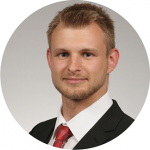 Laser4Fun project. The public defense ceremony took place on-line at the University of Twente and the audience could “attend” the event partly through a video stream.
Laser4Fun project. The public defense ceremony took place on-line at the University of Twente and the audience could “attend” the event partly through a video stream.
We congratulate Marek with this achievement!
Links
- Press release (16 oct. 2020): UT research promotes the start of industrial exploitation of LIPSS
- Summary of the work of Marek Mezera
- Video in which Marek Mezera explains LIPSS and their applications
PhD degree awarded to Vittorio Vercillo
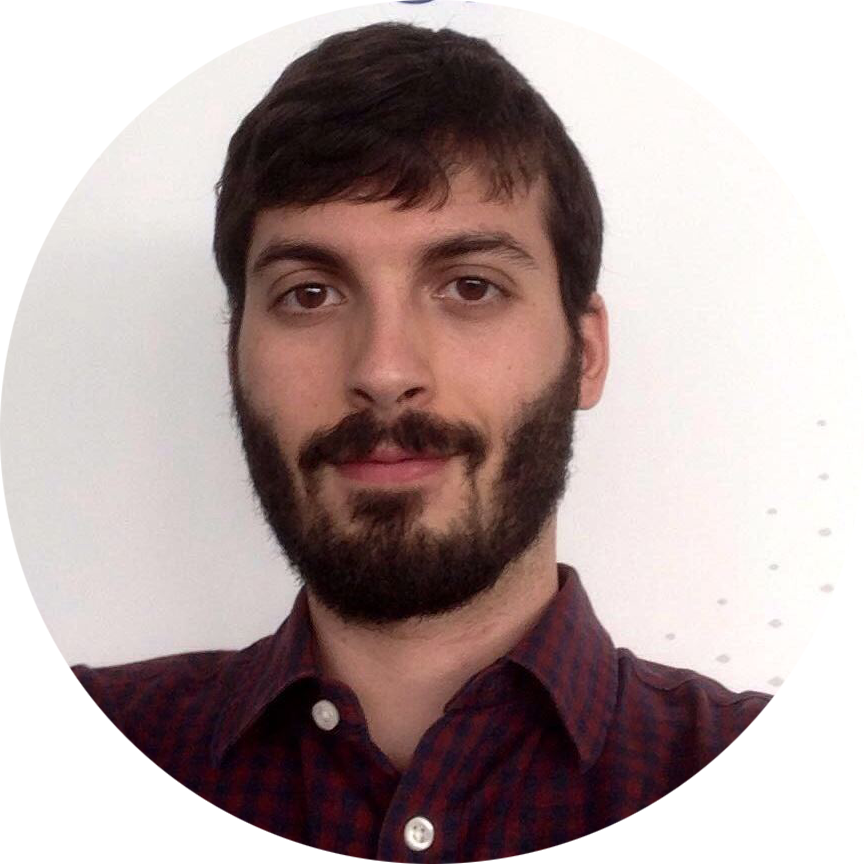
On September 18th, 2020, Vittorio Vercillo successfully defended his PhD thesis, titled “Durable laser patterned metal surfaces with enhanced icephobic properties for aerospace applications” and was awarded the degree of Doctor.
The work was carried out at Airbus Central Research & Technology, as well as at the Technical University Dresden, both in Germany, under the supervision of Dr. Elmar Bonaccurso and Prof. Dr. Andrés Lasagni. The now Dr.-Ing. Vercillo, was an Early Stage Researcher (ESR) of the Laser4Fun project. The public defense ceremony took place with “closed doors” at the Institute of Manufacturing Science and Engineering (IF) of TU Dresden (Germany), with the audience following the event through a video stream.
We congratulate Vittorio with this achievement!
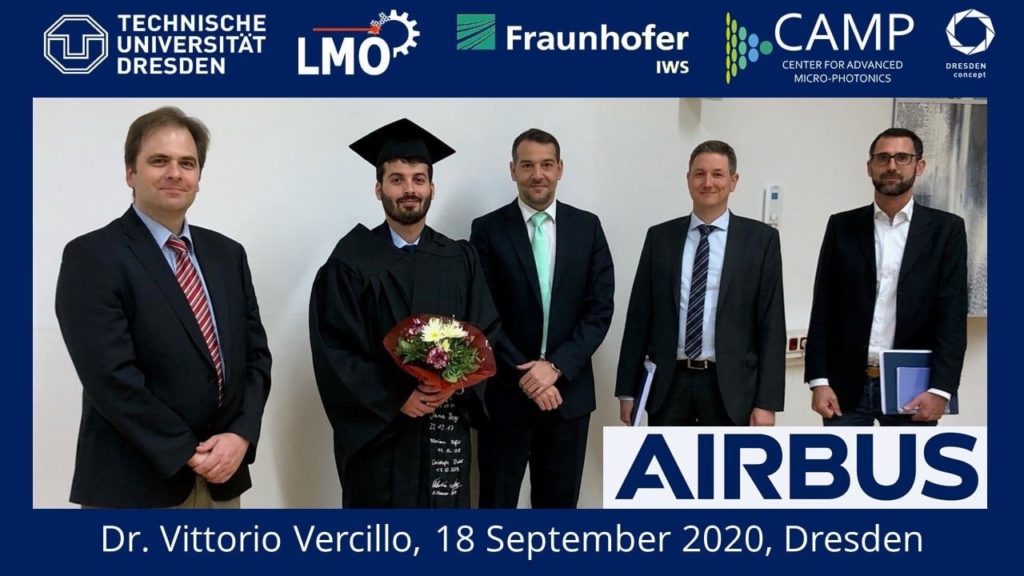
Summary PhD thesis
Ice accreting on external aircraft surfaces due to the impact of supercooled water droplets can negatively affect the aerodynamic performance and reduce the operational capability. Therefore, it must be prevented. Icephobic surfaces capable of reducing the adhesion strength of ice to a surface and to reduce or delay the ice accretion represent a promising technology to support thermal or mechanical ice protection systems. Icephobicity is similar to hydrophobicity in several aspects, and therefore superhydrophobic surfaces embody a straightforward solution to the icing problem. Short/ultra-short pulsed laser treatments have been proposed as a viable technology to generate superhydrophobic properties on metallic surfaces. However, it has not yet been verified if such surfaces are generally icephobic in representative icing conditions encountered by aircraft, or if they need to have additional properties to effectively tackle icing. The research investigates the icephobic properties of laser-treated surfaces of alloys commonly used for aerospace components. Aluminium Alloy AA2024 and Titanium alloy Ti6Al4V surfaces were textured with Direct Laser Writing (DLW), Direct Laser Interference Patterning (DLIP) and Laser-Induced Periodic Surface Structures (LIPSS), using pulse durations from the femtosecond to the nanosecond regime. Altogether, the research advances the knowledge in surface micro-nanostructuring for aerospace applications, addressing the characteristics and limitations of several laser technologies in order to choose the most convenient manufacturing approach.
PhD degree awarded to Sabri Alamri
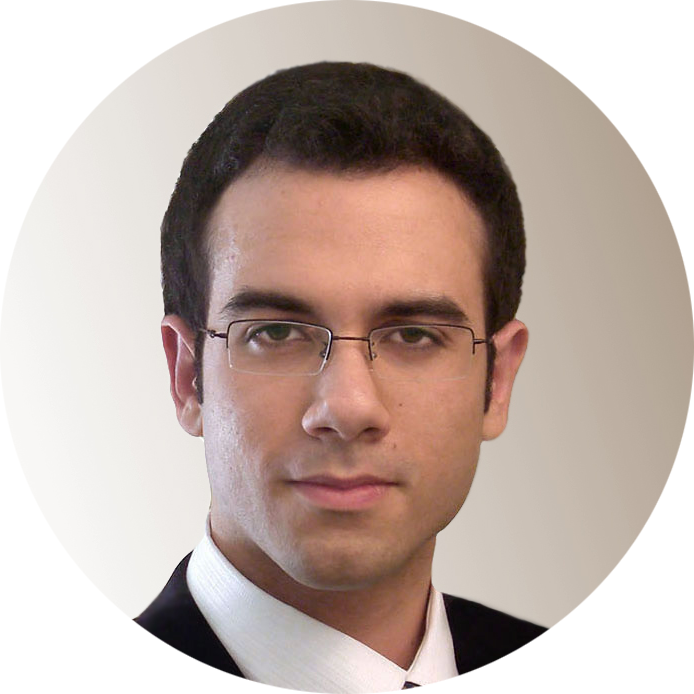
On September 4th, 2020, the Early Stage Researcher Sabri Alamri, from the Laser4Fun project, successfully defended his thesis for the degree of Doctor.
The work titled “Advanced microstructuring strategies of polymers using Direct Laser Interference Patterning” was carried out at Technical University Dresden and the Fraunhofer IWS, both in Germany, under the supervision of Professor Andres Lasagni.
We congratulate Sabri on his achievement!
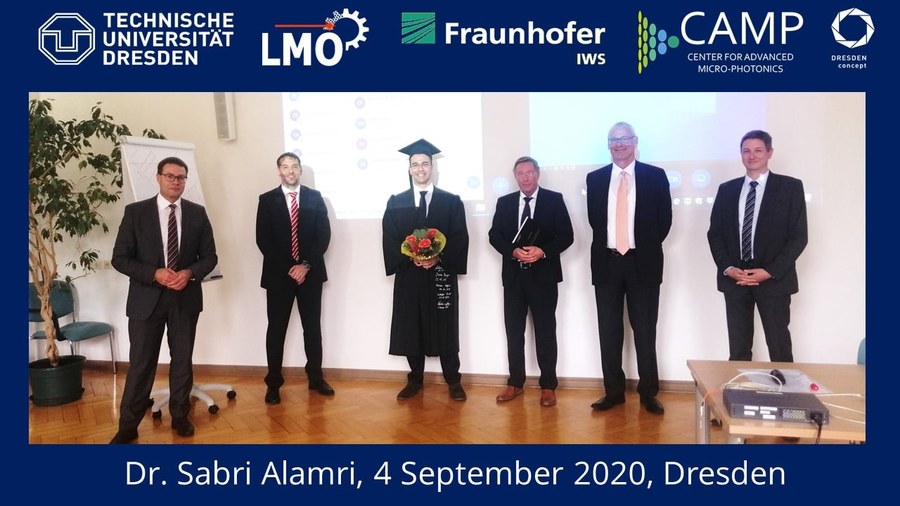
PhD defense ceremony Marek Mezera on Oct. 16th 2020
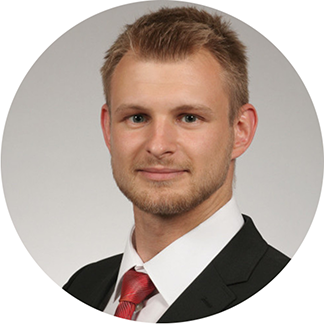 Marek Mezera an Early Stage Researcher (ESR), will defend his PhD-thesis on October 16th, starting at 16:30 o’clock in room 4 of the Waaier building of the University of Twente in The Netherlands. Supervised by prof.dr.ir. Gert-willem Römer and Dr.ir. Dave Matthews, he carried out most of his work at the Chair of Laser Processing at the University of Twente. Below is a summary of the work and results of Marek.
Marek Mezera an Early Stage Researcher (ESR), will defend his PhD-thesis on October 16th, starting at 16:30 o’clock in room 4 of the Waaier building of the University of Twente in The Netherlands. Supervised by prof.dr.ir. Gert-willem Römer and Dr.ir. Dave Matthews, he carried out most of his work at the Chair of Laser Processing at the University of Twente. Below is a summary of the work and results of Marek.
Summary
The interaction of an object with its surroundings depends firstly on the object’s surface, which determines its surface properties due to its chemical properties and macro- and microscopic structures on the surface. Earth’s flora and fauna offers a vast collection of different specialized surface properties due to (hierarchical) micro- and nanostructures. These natural examples serve as a catalog for scientists and product designers who aim for replicating those properties. A one-step method to produce highly regular (hierarchical) nanostructures is to create Laser-induced Periodic Surface Structures (LIPSS). Although extensively studied in the last half century, LIPSS manufacturing did not emerge from an experimental status into industrial applications due to scientific and technical challenges. In this thesis, a picosecond pulsed laser source is evaluated for the potential of processing a large portfolio of LIPSS on different types of materials. Therefore, six research topics are addressed. First, the feasibility of processing LIPSS on polymers using a picosecond pulsed laser source was studied. It was found, that LIPSS can be indeed be processed on two most prominent polymers (polycarbonate and polystyrene) using picosecond pulsed laser sources. The wavelength range, at which LIPSS production was possible was found to be wider than for nanosecond pulsed laser sources, but not as wide as for femtosecond pulsed laser sources. However, the range of peak fluence levels and number of pulses impinging one spot needed to produce LIPSS are found to be similar for all laser pulse durations. Second, the influence of the bulk temperature of a thermoplastic polymer (polycarbonate) on the formation of LIPSS using a picosecond pulsed laser source was investigated. It was found that the peak fluence levels at which LIPSS form decrease with increasing bulk temperature. However, the bulk temperature did not influence the number of pulses impinging one spot necessary for LIPSS development. From this, it can be concluded, that the development of so-called Low Spatial Frequency LIPSS of type II (LSFL-II) is an accumulative process, depending on the number of pulses and that LIPSS formation is strongly affected by the local sample temperatures reached and by the involved strong variations of the polymer viscosity. Third, the formation of LIPSS on a pre-structured polymer (polycarbonate) was examined in order to achieve hierarchical micro-/nano-surface structures. It was found that LIPSS can be formed on top of various forms and sizes of micrometer-sized Direct Laser Interference Patterning (DLIP) structures (ridges) by selecting the laser beam polarization perpendicular to the pre-structured microscopic ridges. Since LIPSS only form in a narrow window of laser fluence levels, the growth of LIPSS only on top of the pre-structured microscopic ridges was limited by the non-normal angle of incidence of the laser radiation at the side walls of the microscopic ridges. Fourth, the feasibility of producing all types of LIPSS known to form on metals due to femtosecond laser pulses, by using a picosecond laser source, with different types of laser polarizations on a medical-grade cobalt-chrome-molybdenum alloy was explored. It was found that indeed all of LIPSS types which form due to femtosecond laser pulses on metals can be produced using picosecond laser pulses. Fifth, a mathematical model was developed to predict the homogeneity of large areas | i.e. larger than the area of a laser spot | of LIPSS depending on laser processing parameters and material constants. The model was validated by experiments on silicon. This model can also be used to optimize laser processing parameters to decrease the production time for large areas of LIPSS. It was concluded, that the model is a convenient tool, which can be exploited for determining the process parameters necessary for the production of large homogeneous areas of LIPSS at the shortest possible production time. Last, it was shown that the LIPSS production time for Low Spatial Frequency LIPSS of type I (LSFL-I) can be further decreased by defocused laser processing. That is, it was shown experimentally that LIPSS produced on silicon do not differ in periodicity and height when processing in focus, or below or above the focus of the laser beam. Hence, to further increase production rates of LIPSS, defocused laser processing is a viable approach.
Effects of mould wear on hydrophobic polymer surfaces replicated using plasma-treated and laser-textured stainless steel inserts
Results of the work in the Laser4Fun project has been published as:
Jean-Michel Romano, Jorge Fantova-Sarasa, Carlos Concheso, Mert Gulcur, Behnam Dashtbozorg, Antonio Garcia-Giron, Pavel Penchev, Hanshan Dong, Ben R. Whiteside, Stefan S. Dimov. (2020) Effects of mould wear on hydrophobic polymer surfaces replicated using plasma-treated and laser-textured stainless steel inserts. Tribology – Materials, Surfaces & Interfaces, 1-13.
Abstract
The mass production of polymeric parts with functional surfaces requires economically viable manufacturing routes. Injection moulding is a very attractive option, however, wear and surface damage can be detrimental to the lifespan of replication masters. In this research, austenitic stainless steel inserts were hardened by low temperature plasma carburising and then different micro and nano scale surface textures, inspired by Lotus leaves and Springtail skins, were laser fabricated. A commonly available talc-loaded polypropylene was used to produce 5000 replicas and thus to investigate the evolution of surface textures both on inserts and replicas together with their functional response. The progressive wear or surface damage on the inserts during the injection moulding process had a clear impact on surface roughness and peak-to-peak topographies of the replicas. In general, polymer replicas produced with the carburised inserts retained wetting properties for longer periods compared with those produced with the untreated replication masters.
